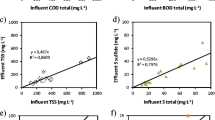Abstract
Purpose
Textile dyeing and sago industries are the most polluting industries in South India, especially in industrial cities like Salem, Tamil Nadu, where textile dyeing and sago industries are clumped together geographically. Conventional physicochemical treatment followed by biological processes for the effluent generated from these industries are ineffective, costlier and produce huge quantities of hazardous sludge and harmful by-products which requires further treatment and safe disposal. Hence, the development of an alternative treatment method will become important. The main objective of this investigation is to establish a sustainable biotreatment technology for the treatment of textile dyeing effluent using sago effluent as co-substrate in a two-phase upflow anaerobic sludge blanket (UASB) reactor.
Methods
In this study, influence of hydraulic retention time (HRT) in a two-phase UASB reactor treating textile dyeing effluent using sago effluent as co-substrate was investigated with different HRTs (36, 30, 24 and 18 h) with an optimum mixing ratio of 70:30 (sago to textile dye wastewaters).
Results
The results revealed that the HRT had a high influence on the chemical oxygen demand (COD) and colour removal. The maximum COD removal efficiency of 39.4% and 88.5% and colour removal efficiency of 43.7% and 84.4% in the acidogenic and methanogenic reactors, respectively was achieved at 24 h of HRT. The biogas production was 312 L/day.
Conclusion
The biphasic UASB reactor could be a very feasible alternative, cost-effective, eco-friendly and sustainable treatment system for textile dyeing effluent with sago effluent as a co-substrate.









Similar content being viewed by others
References
Abraham R (1993) Dyes, environmental chemistry. Encyclopaedia of chemical technology, vol. 8. Wiley, New York, pp 672–783
Agrawal LK, Ohashi Y, Mochida E, Okui H, Ueki Y, Harada H, Ohashi A (1997) Treatment of raw sewage in a temperate climate using a UASB reactor and the hanging sponge cube process. Wat Sci Tech 36(6-7):433–440
Allegre C, Moulin P, Maisseu M, Charbit F (2006) Treatment and reuse of reactive dyeing effluents. J Membrane Sci 269(1–2):15–34
American Public Health Association (APHA) (2005) Standard methods for the examination of water and wastewater, 20th edn. APHA, Washington, DC, USA
Andre BDS, Francisco JC, Jules BVL (2007) Review paper on current technologies for decolourisation of textile wastewaters: perspectives for anaerobic biotechnology. Bioresour Technol 98:2369–2385
Bras R, Gomes A, Ferra MIA, Pinheiro HM, Gonclaves IC (2005) Monoazo and diazo decolourization studies in a methanogenic UASB reactor. J Biotechnol 115:57–66
Cooper P (1995) Colour in dyehouse effluent. Society of dyers and colourists, Bradford
da Silva FM, Tavares CRG, Bonifacio ALE, da Costa RT, Bergamasco R (1999) Hydraulic retention time influence in two-phase anaerobic digestion. ENPROMER ’99, II congresso de Engenharia de Processos do MERCOSUL, Brasil
Easton JE (1995) The dye maker’s view. In: Cooper P (ed) Colour in dyehouse effluent
Grady CPL, Daigger GT, Lim HC (1999). Biological wastewater treatment. 2nd ed. New York: Marcel Dekker
Gnanapragasam G, Senthilkumar M, Arutchelvan V, Sivarajan P, Nagarajan S (2010) Recycle in upflow anaerobic sludge blanket reactor on treatment of real textile dye effluent. World J Microbiol Biotechnol. doi:10.1007/s11274-009-0275-0
Isik M (2004) Efficiency of simulated textile wastewater decolorization process based on the methanogenic activity of upflow anaerobic sludge blanket reactor in salt inhibition condition. Enzyme Microb Technol 35:399–404
Lettinga G, Hulshoff PLW, Koster IW, Weigent WM, de Zeeuw WJ, Rinzema A, Grin PC, Roersma RE, Hobma SW (1984) High rate anaerobic wastewater treatment using the UASB reactor under a wide range of temperature conditions. Biotechnol Genet Engrg Rev 2:253–284
Marco SL, Jose AP (2007) Degradation of reactive black 5 by Fenton/UV-C and ferrioxalate/H2O2/solar light processes. Dyes Pigm 74:622–629
Mustafa I, Delia TS (2006) Biological treatment of acid dyeing wastewater using a sequential anaerobic/aerobic reactor system. Enzyme Microb Technol 38:887–892
Rai SH, Singh S, Cheema PPS, Bansal TK, Banerjee UC (2007) Decolourization of triphenylmethane dye-bath effluent in an integrated two-stage anaerobic reactor. J Env Manage 83:290–297
Seghezzo L, Zeema G, van Lier JB, Hamelers HVM, Lettinga G (1998) A review: the anaerobic treatment of sewage in UASB and EGSB reactors. Bioresour Technol 65:175–190
Singh KS, Harada H, Viraraghavan T (1996) Low-strength wastewater treatment by a UASB reactor. Bioresour Technol 55:187–194
Somasiri W, Wenquan R, Li X, Chen J (2006) Decolourization of textile wastewater containing acid dyes in UASB reactor system under mixed anaerobic granular sludge. Electron journal Environ Agric Food chemistry 5(1):1224–1234
Stanislaw L, Monika S, Renata Z (2001) Biodegradation, decolourisation and detoxification of textile wastewater enhanced by advanced oxidation processes. J Biotechnol 89:175–184
Talarposhti AM, Donnelly T, Anderson GK (2001) Colour removal from a simulated dye wastewater using a two-phase anaerobic packed bed reactor. Wat Res 18(2):425–432
Acknowledgement
One of the authors (V. Arutchelvan) is thankful to the University Grants Commission (UGC), New Delhi, India, for their financial assistance through major research projects.
Author information
Authors and Affiliations
Corresponding author
Additional information
Responsible editor: Hailong Wang
Rights and permissions
About this article
Cite this article
SenthilKumar, M., Gnanapragasam, G., Arutchelvan, V. et al. Influence of hydraulic retention time in a two-phase upflow anaerobic sludge blanket reactor treating textile dyeing effluent using sago effluent as the co-substrate. Environ Sci Pollut Res 18, 649–654 (2011). https://doi.org/10.1007/s11356-010-0409-9
Received:
Accepted:
Published:
Issue Date:
DOI: https://doi.org/10.1007/s11356-010-0409-9




